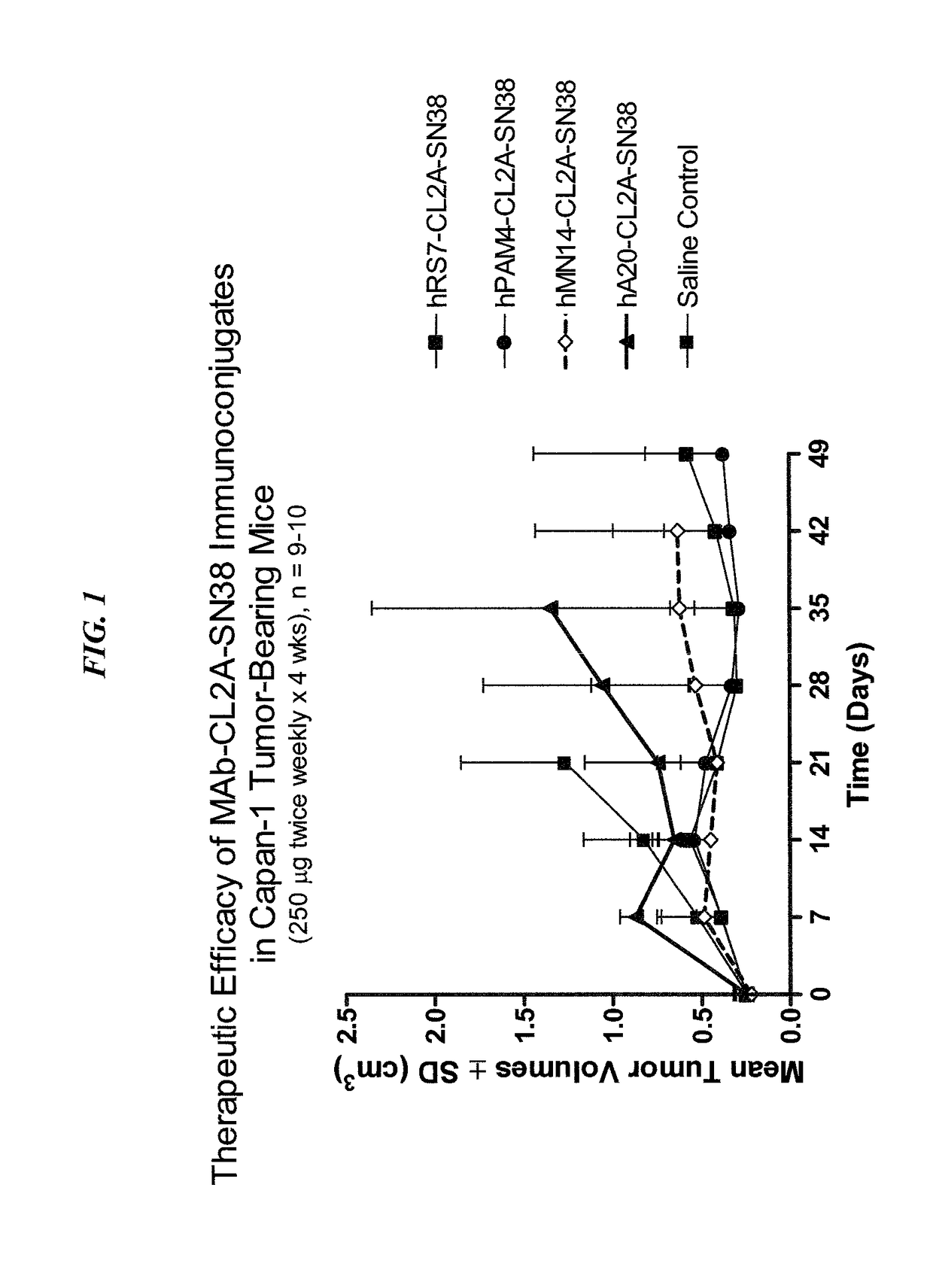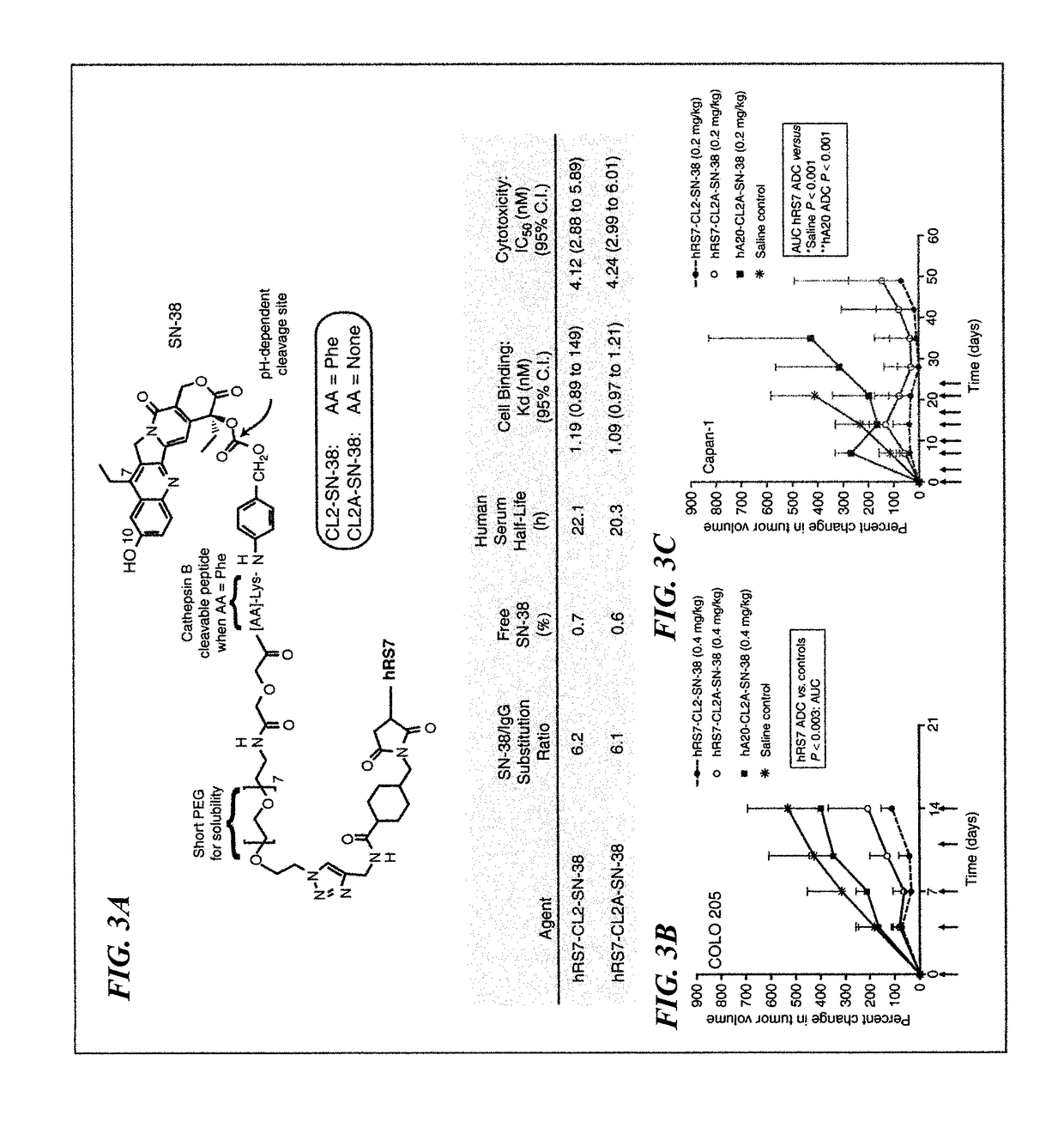Therapy of small-cell lung cancer (SCLC) with a topoisomerase-i inhibiting antibody-drug conjugate (ADC) targeting trop-2
a technology of anti-topoisomerase and anti-tumor, which is applied in the field of anti-tumor antibody-drug conjugates, can solve the problems of single-agent chemotherapies or retreatment with platinum plus etoposide combinations, and the progress in the management of patients with sclc, especially those with extensive disease, has been disappointing, and achieves superior efficacy, reduced toxicity, and increased or decreased dosage and/or frequency of administration
- Summary
- Abstract
- Description
- Claims
- Application Information
AI Technical Summary
Benefits of technology
Problems solved by technology
Method used
Image
Examples
example 1
Therapy of GI Cancers with IMMU-132 (Sacituzumab Govitecan), an Anti-Trop-2-SN-38 Antibody Drug Conjugate (ADC)
[0197]Trop-2 is a tumor-associated glycoprotein highly prevalent in many epithelial cancers. Its elevated expression has been linked to more aggressive disease and a poor prognosis. A humanized mAb binding to the extracellular domain of Trop-2 was conjugated to SN-38 (IMMU-132; average drug:mAb ratio=7.6), the active principle of CPT-11. After potent activity in human tumor xenografts, a Phase I / II trial was initiated in patients (pts) with diverse solid tumors, including GI cancers.
[0198]Methods:
[0199]Patients with metastatic cancers were enrolled after failing standard therapy, starting at a dose of 8.0 mg / kg given on days 1 and 8 of a 3-week cycle. The MTD was determined to be 12 mg / kg; dose levels of 8 and 10 mg / kg were chosen for Phase II testing.
[0200]Results:
[0201]Sixty patients with advanced GI cancers were enrolled in a Phase I / II trial. In 29 CRC patients (9 treat...
example 2
n and Use of Anti-Trop-2-SN-38 Antibody-Drug Conjugate
[0205]The humanized RS7 (hRS7) anti-Trop-2 antibody was produced as described in U.S. Pat. No. 7,238,785, the Figures and Examples section of which are incorporated herein by reference. SN-38 attached to a CL2A linker was produced and conjugated to hRS7 (anti-Trop-2), hPAM4 (anti-MUC5ac), hA20 (anti-CD20) or hMN-14 (anti-CEACAM5) antibodies according to U.S. Pat. No. 7,999,083 (Example 10 and 12 of which are incorporated herein by reference). The conjugation protocol resulted in a ratio of about 6 SN-38 molecules attached per antibody molecule.
[0206]Immune-compromised athymic nude mice (female), bearing subcutaneous human pancreatic or colon tumor xenografts were treated with either specific CL2A-SN-38 conjugate or control conjugate or were left untreated. The therapeutic efficacies of the specific conjugates were observed. FIG. 1 shows a Capan 1 pancreatic tumor model, wherein specific CL2A-SN-38 conjugates of hRS7 (anti-Trop-2)...
example 3
of Anti-Trop-2-SN-38 ADC Against Diverse Epithelial Cancers In Vivo
[0207]Abstract
[0208]The purpose of this study was to evaluate the efficacy of an SN-38-anti-Trop-2 (hRS7) ADC against several human solid tumor types, and to assess its tolerability in mice and monkeys, the latter with tissue cross-reactivity to hRS7 similar to humans. Two SN-3 8 derivatives, CL2-SN-38 and CL2A-SN-38, were conjugated to the anti-Trop-2-humanized antibody, hRS7. The immunoconjugates were characterized in vitro for stability, binding, and cytotoxicity. Efficacy was tested in five different human solid tumor-xenograft models that expressed Trop-2 antigen. Toxicity was assessed in mice and in Cynomolgus monkeys.
[0209]The hRS7 conjugates of the two SN-38 derivatives were equivalent in drug substitution (˜6), cell binding (Kd˜1.2 nmol / L), cytotoxicity (IC50˜2.2 nmol / L), and serum stability in vitro (t / 1 / 2˜20 hours). Exposure of cells to the ADC demonstrated signaling pathways leading to PARP cleavage, but ...
PUM
| Property | Measurement | Unit |
|---|---|---|
| median time | aaaaa | aaaaa |
| median time | aaaaa | aaaaa |
| tumor shrinkage | aaaaa | aaaaa |
Abstract
Description
Claims
Application Information
 Login to View More
Login to View More - R&D
- Intellectual Property
- Life Sciences
- Materials
- Tech Scout
- Unparalleled Data Quality
- Higher Quality Content
- 60% Fewer Hallucinations
Browse by: Latest US Patents, China's latest patents, Technical Efficacy Thesaurus, Application Domain, Technology Topic, Popular Technical Reports.
© 2025 PatSnap. All rights reserved.Legal|Privacy policy|Modern Slavery Act Transparency Statement|Sitemap|About US| Contact US: help@patsnap.com



